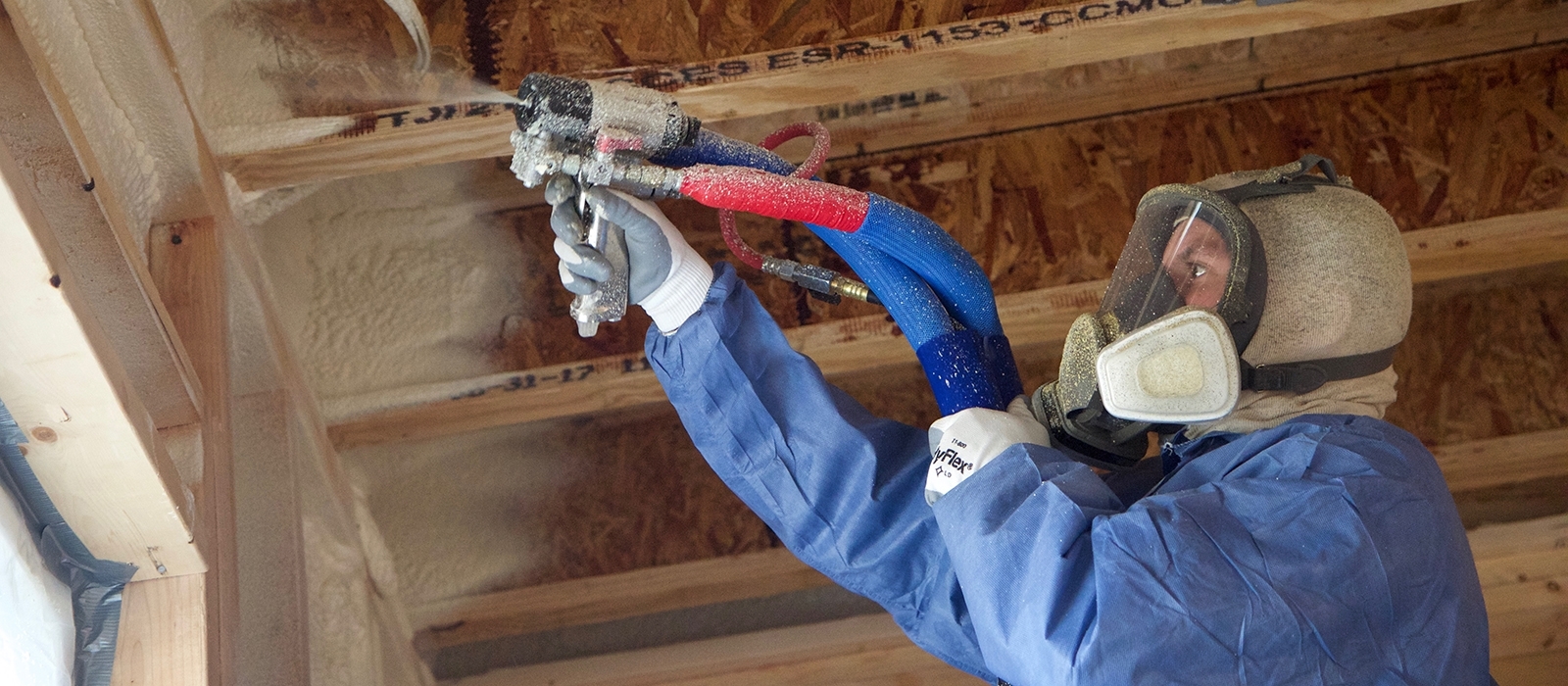The Process of Applying Spray Foam: What You Need to Know
The Process of Applying Spray Foam: What You Need to Know
Blog Article
Exactly How Spray Foam Can Improve Energy Efficiency in Any Kind Of Building
Spray foam insulation has emerged as a critical solution for enhancing energy effectiveness across various structure kinds. By developing a closed seal that reduces air leak, it properly controls indoor climates while significantly lowering cooling and heating expenses. Additionally, its impressive R-value and moisture-resistant homes contribute to long-term power cost savings and improved building long life. As homeowner significantly look for lasting options, the implications of spray foam insulation prolong beyond simple energy savings. The full range of its benefits, nevertheless, warrants a more detailed evaluation of just how it can change energy monitoring strategies in both property and commercial settings.
Understanding Spray Foam Insulation
Spray foam insulation is increasingly recognized for its superior thermal performance and adaptability in different applications. Made up primarily of polyurethane, this insulation material is applied as a liquid that broadens upon get in touch with, loading gaps and creating a seamless barrier. This unique home permits spray foam to adapt uneven surface areas, making it an ideal option for both industrial and household structures.

Application of spray foam insulation is usually executed by trained specialists using specific tools, ensuring optimal efficiency and safety - Spray Foam. The curing process is fast, enabling quick setup and marginal disturbance. Because of this, spray foam insulation is increasingly being employed in new building and construction and retrofitting tasks as a result of its ability to enhance architectural honesty while boosting total power performance in buildings
Benefits of Energy Efficiency
Power performance plays an essential function in reducing functional costs and minimizing environmental impact throughout numerous fields. By maximizing energy use, organizations and house owners can accomplish considerable cost savings on utility expenses, which straight improves economic performance. Reliable energy usage suggests less dependence on fossil fuels, thereby contributing to a reduction in greenhouse gas exhausts and promoting an extra lasting atmosphere.
In addition, energy-efficient buildings frequently experience boosted home worths. As power costs increase and sustainability comes to be a priority for consumers, properties with enhanced energy performance features are much more appealing on the marketplace. This fad motivates financial investment in energy-saving modern technologies, which can further drive development and economic growth.
In enhancement to economic and ecological advantages, energy performance can likewise boost the general convenience and health of indoor areas. Appropriate insulation and reliable heating & cooling systems aid keep consistent temperatures, reducing drafts and humidity degrees, which subsequently can cause far better interior air high quality.
Eventually, the benefits of energy effectiveness prolong beyond immediate savings, cultivating a resilient economic climate, promoting environmental stewardship, and boosting the lifestyle for passengers in any kind of structure.
Exactly How Spray Foam Works
Typically used as a fluid, spray foam broadens rapidly upon call with surface areas, forming a strong obstacle that effectively secures fractures and gaps. This unique residential or commercial property results from its chemical structure, mainly including polyols and isocyanates, which react when blended to produce a foam that sticks and fills up gaps to different products, consisting of concrete, timber, and metal.
When applied, the foam broadens to several times its original quantity, guaranteeing a tight seal that stops air leak. This procedure significantly reduces thermal connecting, which takes place when heat transfers with products, causing energy loss. The foam's high R-value, a procedure of thermal resistance, adds to improved insulation by lessening warm transfer in between the inside and exterior atmospheres.
In addition, spray foam is resistant to moisture and bugs, further enhancing its effectiveness in keeping power efficiency. Its application can be customized to various locations, consisting of attic rooms, wall surfaces, and crawl spaces, enhancing insulation throughout a structure. Spray Foam. On the whole, the innovative design and application technique of spray foam make it click to read more an efficient option for boosting power effectiveness in any kind of framework, leading to minimized energy prices and an extra sustainable constructed setting

Applications in Different Buildings
Many applications of spray foam insulation can be located across numerous building kinds, enhancing power performance and convenience. In residential homes, spray foam is usually used in attic rooms and walls to create a seamless obstacle against air leaks, significantly lowering heating and cooling needs. This application is specifically useful in older homes, where standard insulation might be inadequate.
In industrial structures, spray foam insulation is used to roofing system his response systems and exterior wall surfaces, which helps to improve thermal performance and shield versus moisture breach. Its lightweight nature makes it an optimal selection for retrofitting existing frameworks without adding substantial weight. Additionally, spray foam can be used in industrial setups to protect pipelines and tank, keeping temperature level control for sensitive materials.
Institutional buildings, such as medical facilities and institutions, gain from spray foam insulation by making sure a regular interior climate that supports passenger comfort and health and wellness. The adaptability of spray foam enables it to adjust to numerous structure forms and dimensions, making it a favored option for designers and builders looking for efficient insulation remedies. Generally, spray foam insulation serves as a crucial part in accomplishing energy-efficient structures throughout all markets.
Long-Term Price Cost Savings
Spray foam insulation offers substantial long-lasting expense savings for structure owners and residents by reducing power usage and lowering energy bills. By giving a premium air seal, spray foam lessens the infiltration of outdoors air, therefore boosting the thermal efficiency of a building. This causes much more efficient home heating and cooling processes, which can cause substantial decreases in energy prices gradually.
Along with prompt cost savings on energy expenses, the durability and long life of spray foam insulation add to its financial benefits. Unlike traditional insulation products, which might sag, settle, or degrade, spray foam maintains its efficiency for years, decreasing the requirement for constant substitutes or repairs. This durability converts to lower maintenance prices and less interruption for owners.
Furthermore, structures equipped with spray foam insulation commonly enjoy a boost in property value, making them a lot more enticing to potential purchasers or occupants. As power performance becomes increasingly prioritized, properties with efficient insulation options attract attention in the market. Eventually, the assimilation of spray foam insulation not just boosts convenience but also stands for a strategic financial investment that produces substantial economic advantages over the lengthy term.
Conclusion
To conclude, spray foam insulation serves as a crucial element in improving energy efficiency throughout varied structure kinds. Its ability to produce a seamless barrier against air leak, integrated with moisture-resistant residential properties and high r-values, dramatically minimizes energy consumption and associated expenses. The implementation of spray foam not only adds to constant indoor temperature levels yet additionally boosts building value, underscoring its duty as a prudent financial he has a good point investment for both business and domestic residential or commercial properties.
Spray foam insulation has actually arised as an essential service for boosting energy performance across different structure types. Spray Foam. As an outcome, spray foam insulation is progressively being used in new construction and retrofitting projects due to its capability to enhance structural honesty while enhancing total power efficiency in buildings
Overall, the ingenious layout and application method of spray foam make it an effective option for boosting energy effectiveness in any kind of structure, leading to reduced energy expenses and an extra lasting built atmosphere.
Countless applications of spray foam insulation can be discovered throughout various building kinds, boosting power effectiveness and convenience.In conclusion, spray foam insulation serves as an important element in improving power efficiency across diverse building types.
Report this page